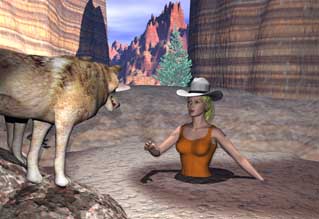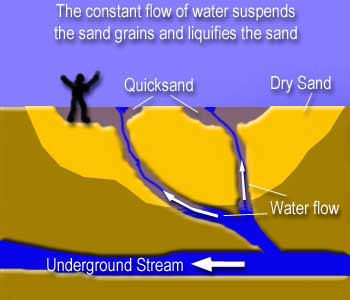The UnMuseum - Quicksand (original) (raw)

Never hike alone. Falling into quicksand and not being able to get out by yourself can be fatal (Copyright Lee Krystek, 2006).
Watch out! Quicksand!
Being sucked into quicksand is a staple of many 'B' movies, but is this phenomenon of nature really as dangerous as it is portrayed?
Jack Pickett and his friend Fred Stahl, both college students, decided to spend the day looking for parasitic plants in the swampland south of Florida's Lake Okeechobee. Pickett was in the lead walking along the sandy bank of a small stream when suddenly his feet disappeared into the sand. "It's soft here! Stay back!" he warned his friend. The ground seemed to swallow him up and he was quickly chest deep in thick muck. The sand pinned his arms to his body as he struggled to release the heavy pack on his back that was dragging him down. "It's quicksand!" he shouted, "Help me!" Desperate to assist his friend, but fearing getting trapped himself, Stahl searched for a tree branch to extend his reach. Finding one, he held it out. Pickett couldn't free his hands to grab the limb and sank deeper and deeper into the sand until he simply disappeared�
The above is not a scene from a TV drama or action film. This was a real incident that occurred in 1964. It's not only people who vanish into quicksand, but animals, cars, trucks and at least one railroad locomotive have disappeared without a trace. What is quicksand and why does it seem to suck things down? Well, despite the above story, most quicksand is not usually deadly. However, it is a fascinating phenomenon of nature that requires our careful respect.
Sand and Flowing Water
Quicksand is formed when regular sand, mud or even gravel comes in contact with a flowing water source, usually an underground stream or spring. Under normal conditions the tiny grains in sand or other material will rub up together with enough force, or friction, to support the weight of someone or something on top of it. You can see this when you go to the beach. Even in loose, dry sand your foot only sinks a couple of inches before the friction between the sand grains grows high enough to stop you from going down any deeper. What if the something lessens the friction between the sand particles? Would you go down further?
This lessening of the friction is exactly what happens in quicksand. The flowing water moves between the particles of sand and acts as a lubricant to reduce the friction. The grains become suspended in the water and the sand changes to a liquefied state. As long as the water keeps flowing, the quicksand bed will exist. Small patches of quicksand appear at the edge of almost every beach as the incoming waves force seawater in among the sand particles at the waterline. That's why if you stand in the surf you can feel your feet sinking into the sand a little bit more with each new wave. Fortunately, this kind of quicksand is rarely dangerous. The action of the waves only creates a quicksand patch a few inches deep, not enough to trap even a child.
Quicksand that forms in a patch more that a few inches deep, however, can be dangerous. Typically, despite stories about quicksand beds with bottomless pits, most quicksand is only waist deep. The biggest danger an adult faces in such a pit is getting stuck and not being able to climb out by himself. If he is alone, he can face death from starvation or exposure to the cold. In some wilderness areas people trapped and unable to defend themselves have been mauled by animals such as bears or wolves. For this reason it is never a good idea to go hiking alone, especially in areas where quicksand is known to exist.
Places with a lot of water may often have areas of quicksand: marshes, rivers, creeks, seashores and swamps can all have pools. Places with underground sources of water like the Colorado Mountains and parts of Texas and Utah can also generate quicksand beds. One place quicksand is almost never found is the desert. Deserts have plenty of sand, but without water quicksand cannot form.

Quicksand has existed as long as there has been water on the planet. Some of our best preserved bones from dinosaurs and other prehistoric creatures have come to us because these animals got caught in a quicksand bed. Since the animals slide rapidly under the sand it actually protects their remains from weather damage and scavengers. Thousands or even millions of years later when the quicksand has dried out and turned to sandstone, paleontologists can dig out the bones and reconstruct the creatures' skeletons. One interesting example of this was excavated in the 1960's at Tugrugeen in Outer Mongolia when two dinosaurs bones were found locked in combat. A predatory velociraptor was found on top of a herbivore rotoceratops which was sprawled on its back. Scientists speculate that they were fighting when they fell into a pool of quicksand and both died.
It is often difficult to spot a pool of quicksand before walking into it. Leaves and sticks can lie on the top, concealing the pit. A crust of dried sand can form on the top hiding the liquefied material below until some steps on it and falls through. Quicksand can also form underwater and can snag people or animals as they attempt to cross rivers or walk along the edge of ocean or lakes. In these situations drowning is a strong possibility.
Unable to Escape the Water
Tidal flats can be particularly dangerous. In one unfortunate case in September of 1988 a woman in Alaska got caught in the mud flats near Turnagain. Adeana Dickinson and her husband were using an ATV to cross the flats when the trailer they were towing got stuck. She hoped off the back to push it out and her legs got caught in the mud. The patch she was stuck in was not light sand but powered rock, making the material particularly heavy. Her husband worked for two hours and managed to free one leg before the tide started coming in. Emergency rescue was called and a team worked to free her, but was forced to back off and watch her drown as the sea rose around them.
Should you fall into a patch of quicksand the first thing to remember is not to panic. Thrashing about can get you more stuck. Quicksand is a lot denser than water and a person will float much more easily than in a pure liquid. It is important, however, to quickly get rid of any weight you are carrying (like a backpack) that might drag you down. While deep pits of quicksand do exist, most are fairly shallow and you should be able to touch bottom. If you cannot touch bottom it may be difficult to extract yourself without help if you have nothing solid to push against. The quicksand flows around legs and arms and trying to pull them out creates suction. The best method to get out of a quicksand bed if you can't push against solid ground or have somebody pull you out with a rope is to try swimming out with slow, deliberate motions. A scientist with the U.S. Geology Survey once fell into quicksand while exploring the Colorado River. Unassisted he slowly swam through the thick mud to solid land. It took him eight hours to move just ten feet, but he was able to walk away from the experience uninjured.
Occasionally unusual conditions can liquefy the ground that was solid a few minutes before. In the 1800's a Kansas Pacific Railroad train fell into a quicksand creek bed during a flood. While some of the cars were recovered, the 200-ton engine sank so deeply into the liquefied ground that it was never seen again.
Earthquake Liquefaction
Earthquakes can also change the solidity of the ground. When the pressures and vibrations created by the quake reach damp soil, they can increase the water pressure in the soil, pushing apart the particles and reducing friction. The lowered friction allows the ground to suddenly liquefy. Since much of man's infrastructures are built on the assumption that the ground is solid, such a change can have devastating effects on structures. During the great 1906 earthquake in San Francisco, gas and water pipes snapped as the ground around them started moving. The resulting gas leaks led to fires around the city and the damage to water lines meant there was no way to put them out. In 1964 liquefaction during an earthquake in Niigata, Japan, caused apartment houses to tip over like dominos as portions of their foundations could no longer support their weight. Fortunately the buildings toppled over slowly and stayed intact, allowing residents to escape by climbing out their windows and walking down the face of the building which was now level with the ground.
Liquefaction of the ground during an earthquake is fairly rare and scientists and engineers are working on ways to predict what areas might be subject to turning into quicksand and how to protect structures if it does. It is more likely that the average person will run into quicksand on a hike or along the beach rather than during an earthquake.
An encounter with quicksand need not be a disaster, as pictured in Hollywood movies or TV. Common sense can help people avoid quicksand beds in the first place and keeping calm will assist them should they fall in. Quicksand is not some supernatural creature trying to gobble down anyone that falls into its clutches, but it is an interesting and potentially dangerous phenomenon of nature.
A Partial Bibliography
Monstrous Mysteries by Lynne Snifka ,Alaska Magazine 2004. http://www.alaskamagazine.com/stories/1004/feature\_mystery.shtml
Quicksand by Kris Hirschmann, Kidhaven Press, 2003.
1964 Earthquake Niigata by J�rgen Johansson, Japan Department of Civil Engineering, University of Washington, January 27 2000. http://www.ce.washington.edu/\~liquefaction/html/quakes/niigata/niigata.html
Copyright Lee Krystek 2006. All Rights Reserved.
